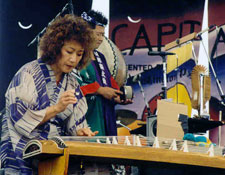| Alexandria, VA
May 2, 2005
 It's always exciting when Hiroshima returns to the Nation's Capital to perform. Washington, DC loves Hiroshima and for good reason. They performed their first ever east coast tour date right here at Howard University's Crampton Auditorium back in the late ‘70s. With their one-of-a-kind sound, this band has been a favorite among the crowd here for more than 25 years. This year, with the release of Obon, we anxiously anticipated being the first stop on the tour and hearing the new material performed live for the first time. It's always exciting when Hiroshima returns to the Nation's Capital to perform. Washington, DC loves Hiroshima and for good reason. They performed their first ever east coast tour date right here at Howard University's Crampton Auditorium back in the late ‘70s. With their one-of-a-kind sound, this band has been a favorite among the crowd here for more than 25 years. This year, with the release of Obon, we anxiously anticipated being the first stop on the tour and hearing the new material performed live for the first time.
The set list ran the full gamut, from the very first song Hiroshima ever recorded back in 1979, to selections from their most recent release. The concert began with the 1981 Grammy nominated “Winds of Change” (Henka No Nagare) from 1980s Odori. Next, they broke into songs from their new recording, including the opening track and first single, “Swiss Ming.” The band continued with “China Latina,” which was enhanced by the addition of Shoji's percussion playing, and then the lovely June Kuramoto tune, “One Thursday Morning.” These new songs were everything I had envisioned them to be. They sounded as good live as I knew they would.
With Hiroshima, you don't just get music, you get an education. Tonight's lesson focused on human rights. “Mr. Robben,” another song from the new CD, is a tribute to Nelson Mandela, and was inspired by a trip to the infamous Robben Island Prison in South Africa. They then played the moving piece, “Manzanar” from 2003s The Bridge. This song is dedicated to their family members who were interred in the prison camp of the same name during WWII. Dan informed the audience that this year is the 60th anniversary of the interments.
 The mood picked up, and the audience got into the very up-tempo “San Say” (Third Generation, 1983). By now the audience was very much into the show, especially after the sometimes playful koto solo that June played for us. Everyone was having fun. Even bass player Dean Cortez broke into a riff from “Papa Was a Rolling Stone” during this song. (This seems to be a popular riff among bass players.) The mood picked up, and the audience got into the very up-tempo “San Say” (Third Generation, 1983). By now the audience was very much into the show, especially after the sometimes playful koto solo that June played for us. Everyone was having fun. Even bass player Dean Cortez broke into a riff from “Papa Was a Rolling Stone” during this song. (This seems to be a popular riff among bass players.)
June then performed the title song from her solo CD, Spirit and Soul (2003), which she dedicated to the Native American people.
As with every Hiroshima show I've attended, one of the things I look forward to is the middle of the show. Everyone but the drummer and taiko player leave the stage. Drummer Danny Yamamoto plays a steady beat while taiko player Shoji Kameda takes center stage and wows us with his vocalese, which I later learned is called Tibetan throat singing. Shoji also plays a Japanese instrument called a uchiwa taiko, or a fan drum, which sort of resembles a tennis racket. Then he resumes playing the taiko alongside the drummer until they're both playing in unison on their respective drums. It's amazing to watch and astounding to hear.
I don't know if it's characteristic of Shoji or of taiko players in general, but he doesn't just stand there and beat the drum. His movements are very big, very fluid. It is indeed a performance.
When the full band rejoined the stage, they played “Obon Two-Five,” another tune from their new album. This is a great tune which had me dancing in my seat. They ended their regular set list with “Hawaiian Electric,” from their Go CD (1987), which included a very enjoyable Latin-sounding keyboard solo by Kimo, and a fantastic drum solo by Danny.
They left the stage to thunderous applause and shouts from the audience. The band encored with their hit song, “One Wish.” Kimo playfully teased us with the opening notes until they finally began the song. They played two encore songs. They did not give away the title of the second song. Dan only said it was the first song from the first album they recorded. I'm sorry to admit that I didn't know the name of the song, but one lucky man in the audience was the first one to shout it out, so he got a free CD. It was “Lion Dance” from the self-titled Hiroshima (1979).
If this show passes through your area, I encourage you to see it. You just can't pass up the opportunity to see and hear what makes Hiroshima such a unique talent: the chance to see and hear the lovely June Kuramoto, a taiko master, play her instrument, and a chance to experience the taiko as well as other Japanese instruments. The other musicians in the band, all seasoned veterans, only add to the experience.
- Mary Bentley
photos by Harvey Cline
|

